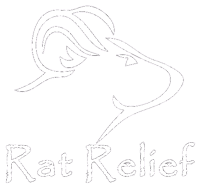Rodent Droppings: Rats, Mice, Squirrels & Other Rodents
Is there a pest living with you? House rats, mice, and squirrels may be too sneaky for you to see and catch them in the act. But while you may not see one, what may catch your eye is their poop.
One of the ways you can identify what type of pests breed in your area is their droppings.
Get a Fast FREE Quote Today!
HOW DO YOU IDENTIFY RODENT DROPPINGS: TYPES & INDICATION
At the end of the day, you must figure out how to clean and disinfect your place and get to the root of all problems. Know what pesters you. Eradicate them after you decode these animal instincts. What type of species they belong will tell you where they potentially made a dwelling. Rodents may crawl in your vents, pipes, or underground rooms and through wall gaps. Look for rodent poop trails and trace where they are!
HOUSE MICE or FIELD MICE
House mice or field mice are the most common rodent species. They multiply fast, outnumbering the human population. A house mouse poop is what you will often find in homes.
They like to be in dark places. Corners and small openings like holes in the walls are where you could find a band of them huddled together. They love squeezing into narrow spaces.
You can hear them at night crawling and squeaking in the kitchen, climbing up the cupboards. House mice feed mostly on grains and cereals. So be prepared! If these little creepers are dwelling in your homes, they are sure to rummage your cereal boxes, rice dispensers, or pantry. They’re sneaky, so if they hear you coming in, they’ll be gone. However, you will see their droppings left on the surfaces.
How to Identify House Mice Droppings:
Size and Shape
House mice droppings are small. If you compare it to a size of a rice grain, it will appear smaller and have pointed ends. The shape looks skinny and would measure about 1/16 inch thick and 3/16 in length.
Pooping Behavior
Indiscriminate, leaves a trail on surfaces
Color
When fresh, their droppings are dark brown. When dried, they turn lighter. Fresh poop will look shiny and will become hard or crumbly as it dries.
Quantity
Mouse poop comes in masses. They amount to 70 to 150 droppings a day.
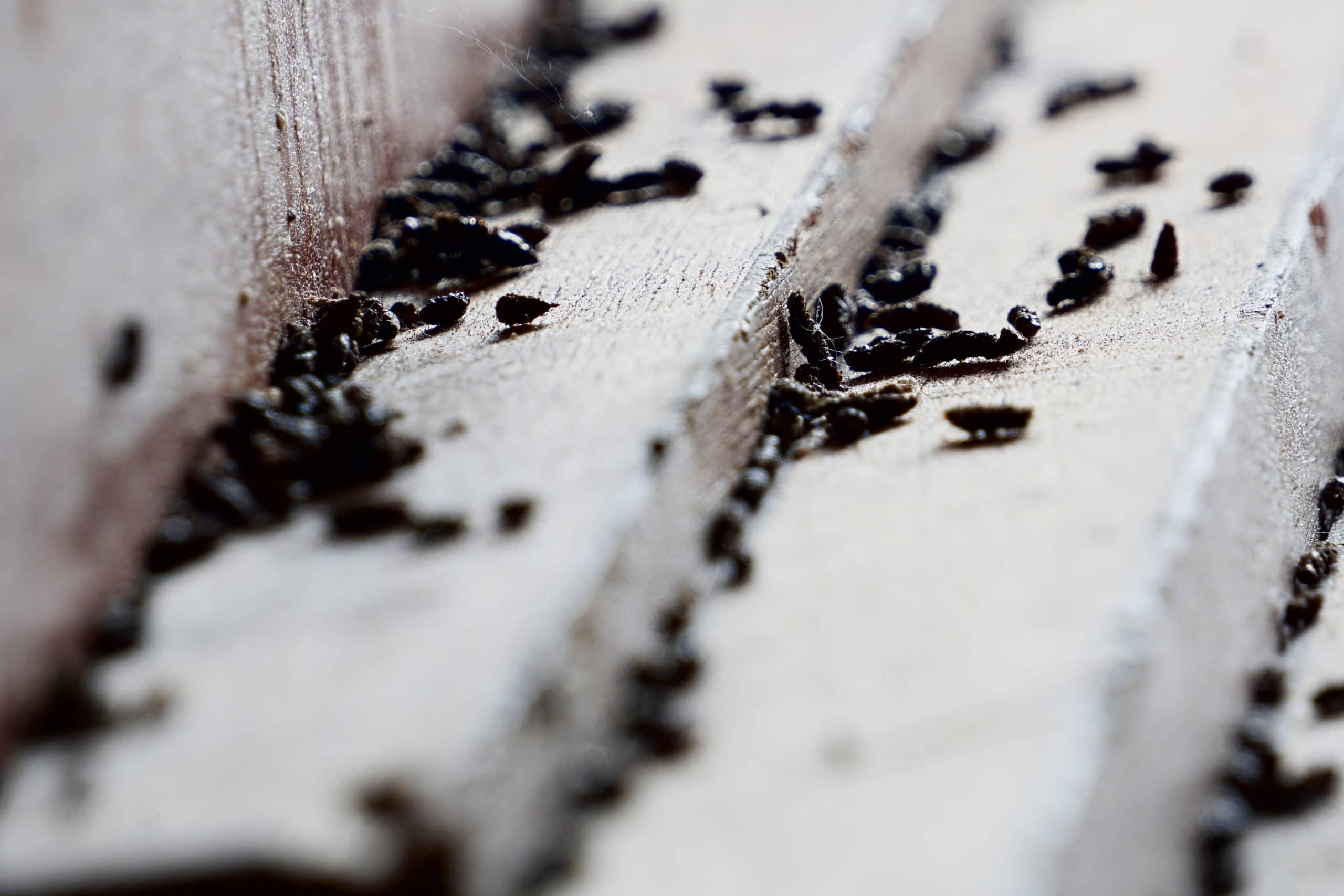
ROOF RAT
Roof rats, as the name suggests, frequents the roof. They dwell in elevated spaces. You can also see them climbing trees. They run up the walls to the ceiling, climb and crawl vents, and you may see their droppings stuck in these high places.
How to Identify Roof Rat Droppings:
Size and Shape
Rat vs Mouse poop: Rat droppings are larger. They are about a quarter to half an inch. For roof rats, their poop will have pointed ends, like those of the house mice, but they are rather thicker and longer.
Quantity
35 to 50 pellets in a day
Color
Fresh rat droppings are dark, black, and shiny. When they dry, they get hard and brittle.
Pooping Behavior
Indiscriminate, leaving trails and gnaw marks
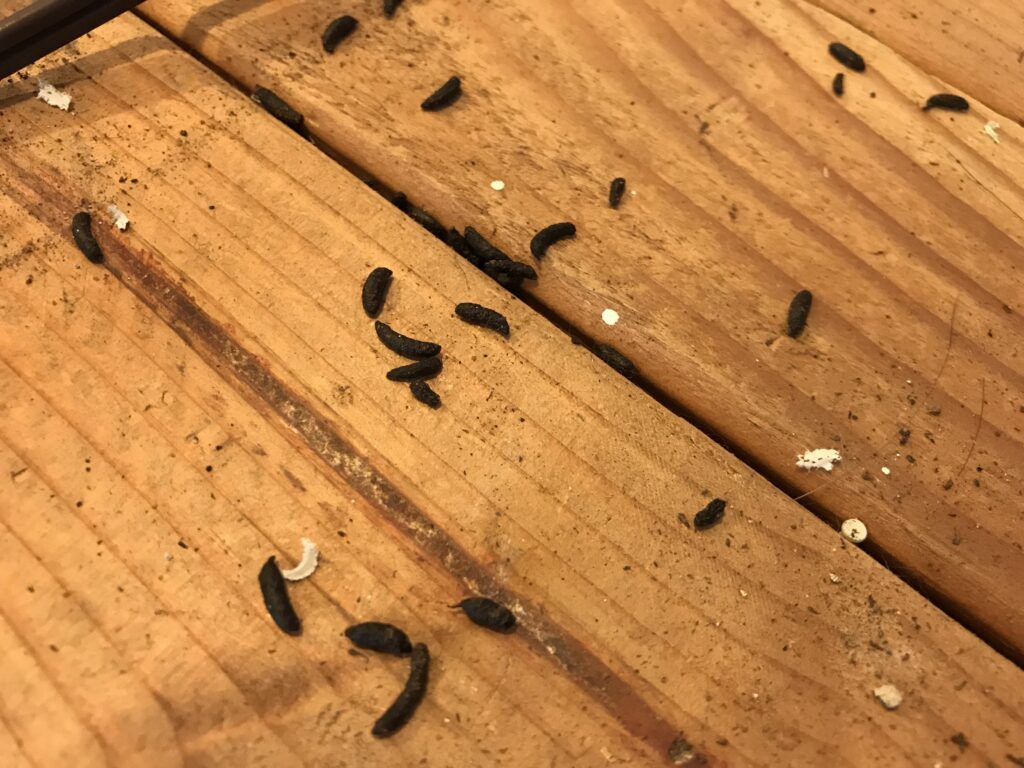
NORWAY RAT
An opposite of the roof rats is Norway Rats. These Norwegian export rodents like to live underground. Like roof rats, will have a poop a size larger than a rice grain. Their poop will appear blunt or a little curvy on its ends.
How to Identify Norway Rat Droppings:
Size and Shape
Measure up to half an inch. Generally, their poop will be larger than roof rat poop. They also differ in shape, appearing to be blunt, close to being round. They’re thicker than roof rats’ and shorter than the field mice’s droppings.
Quantity
35 to 50 droppings a day
Color
Like roof rats’ poop, a Norway rat’s dropping will look dark and almost black or dark brown.
Pooping Behavior
Indiscriminate, leaving trails and gnaw marks
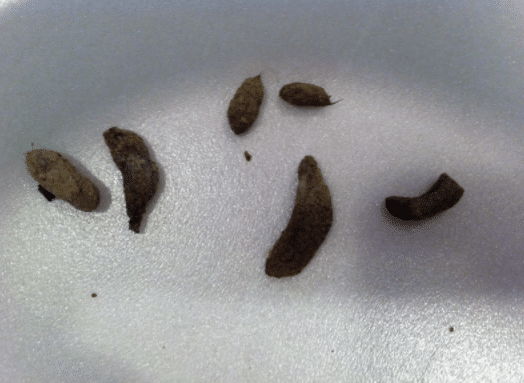
SQUIRRELS
Squirrels are considered pests in some areas. You would agree when you find out through their poop why. The squirrel may leave and gather their droppings in mounds.
Sometimes you could see sticky pellets collected in one corner, or sometimes squirrels left them under shaded areas like under the tree or under window sills.
How to Identify Squirrel Droppings:
Size and Shape
A mass of squirrel litter will have variants of sizes, with ⅛ inch long on average. Litterings left by squirrels can look like rat droppings, as well. They will, however, be a little thicker.
Also, it got a bulge in the middle and a little smaller than those of the rats. Their ends will also be rounded, forming oblong-shaped or cylinder-like pellets.
Quantity
Above 50, you will see them in groups.
Color
Fresh squirrel droppings will also appear dark brown. When you see a mound of them, they leak coffee-stain-like residue. As time goes by and they dry, they will get lighter and lighter.
Pooping Behavior
Squirrel droppings come in groups normally found collected or discriminate in one spot.
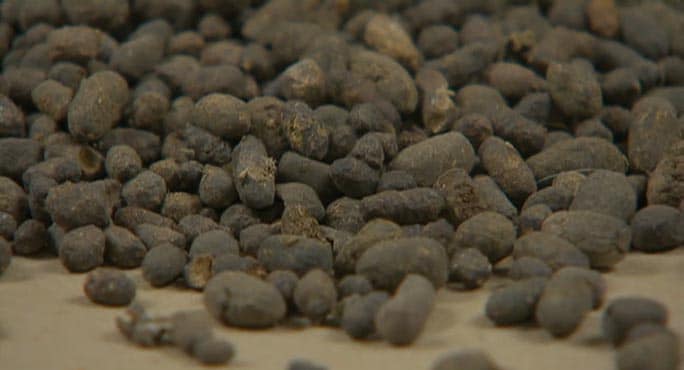
Identifying Other Pest Droppings
Aside from the rodent’s droppings, there may be other similar and closely related poop species scattered in and out of your premises. Here are common other pests droppings to look out for:
Bats
Bats are like flying mice. So is the look of their poop. The litter they leave behind may be similar in size to those of the rats. They are like small rice grains, with a touch of creativity, coming in varying sizes and sometimes irregular shapes.
These are usually gathered in clumps, like those of the squirrel. And, most times, you’ll see them lumped on urine.
Bat Poop
Skunk
Skunk droppings can be compared to the size of those from cats. A striped skunk litter will measure 4 to 5 inches.
The spotted skunk’s litter will be half a size smaller and will have more blunted ends.
Skunk Poop
Possum
Possum litter is similar to dogs. They are larger, about ¾ in diameter.
Most are curly, rarely straight. And when the litter is dried, it will grow in molds.
Possum Poop
Raccoon
Raccoon droppings are similar to that of dogs. They usually feed on corn and fruits, and when they litter, those food reams will appear on their poop.
Raccoon Poop
Cockroaches
Cockroach droppings are also one of those that tell you if the infestation is around your area. So, to give you a look at what their litter looks like, here it is. Cockroaches vary in size, and so are their poop. Small ones would leave tiny black circular poop and would appear like black pepper.
More gigantic cockroaches will have enormous poop and will look cylindrical.
Cockroach Poop
Do's and Don'ts: Why Call The Experts When you See One
DIY Pest removal and rat extermination come in handy for you! You’ll cut expenses and get rid of the problem immediately. However, when it comes to relentless pests such as rodent and large scale rat infestation, you need a permanent solution. You have to make sure they will not keep coming back. You may take them out with easy and accessible DIY traps or baits. These are only temporary.
Another, take note, too, that pests are still animals, and you need to consider some animal welfare protocols when killing a population of rats and other pests. Disposing of them may be a challenge and may take a toll on your time and effort. Where will you put remains, and how will you make sure no offspring will get back to you? Have you considered exclusion? What are other ways you can secure your area rodent-free?
Here are do’s and don’ts you need to keep in mind when handling pest and rodent control!
What do you DO if you find rodent droppings?
- Check if droppings are found both outside your homes and inside. This means infestation exists.
- Check for holes around your home’s openings. These are where the pests find entry to your house.
- Place traps and rat poison near tiny holes that you know rodents come in and out of.
- Place rat traps near windows, doors, and other openings. You may need to put traps near vent openings, too.
- If you want to know precisely how bad infestation had become, call rodent control professionals.
- Call rat relief experts to clean and end the infestation. Before you restore your area in perfect order, you need to make sure not one species is left.
What you DO NOT do if you find rodent droppings?
- If infestation is sure around your home and near the area, then do not rely on traps. Is it a mouse or rat? One species is suspicious of traps and may not bite the bait.
- Traps are not enough. Do not repeat the same tactics. Rodents are instinctive animals. You must be smarter than them. Hence, for solving rat problems, you sure need the experts’ knowledge.
- Do not throw a dead pest near your garbage area. Pests carry germs and diseases. Do not risk your health by getting near any dead pests.
- Do not use poison without a strategic way to find them. Poisoning rodents is often sufficient. But, you may deal with smelly problems if a body lies somewhere out of your sight and out of your reach! Call the experts to handle this!
NO TOUCH! Mouse, Rat, & Rodent Droppings
Leave it to the rodent & pest control experts
Rid of rodents and other pest infestations! Leave no trace and leave no trail of droppings in your properties! Professional Rat Relief and Pest Control Services now near you! We will scout your area and test signs of what pesters you! Call us today! Free Estimate!

